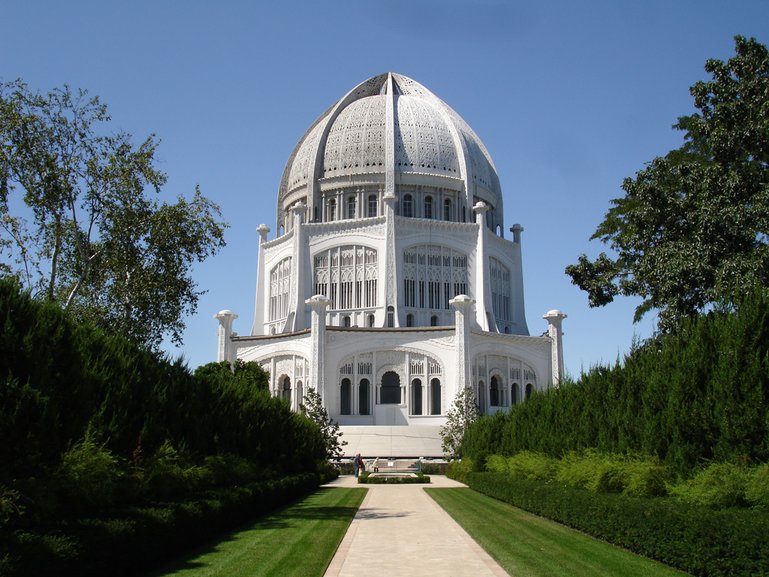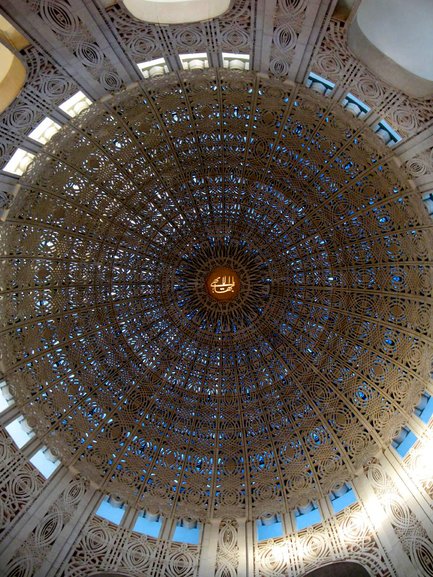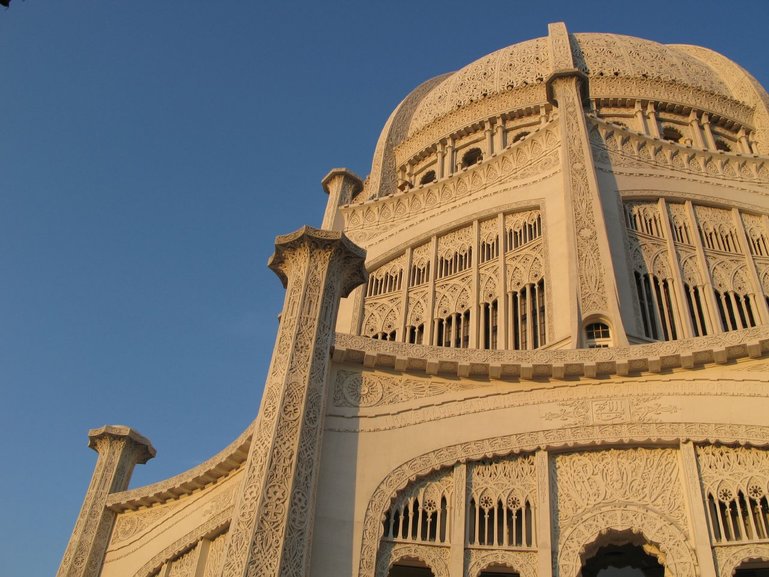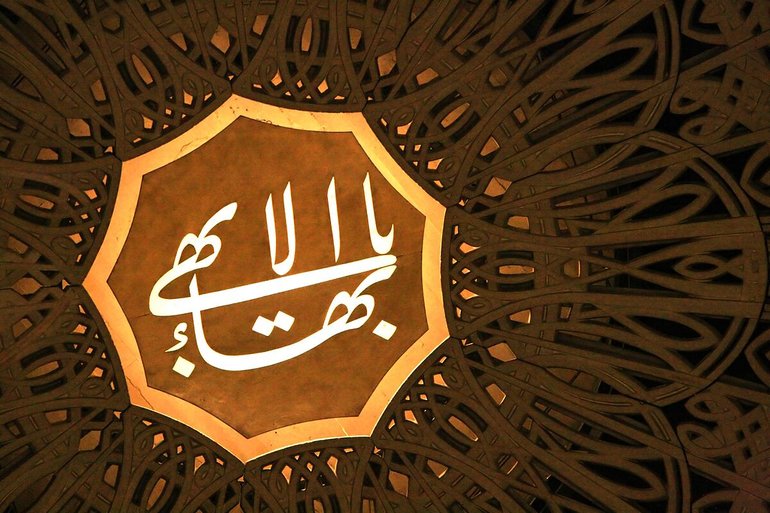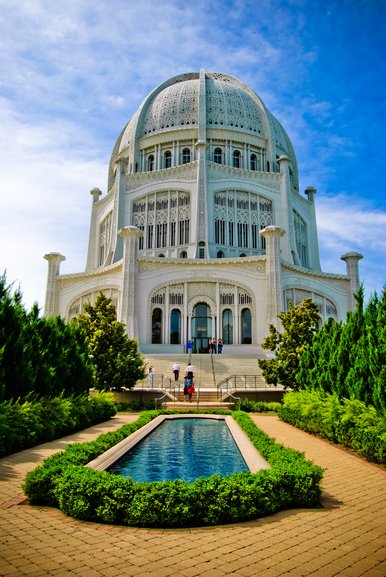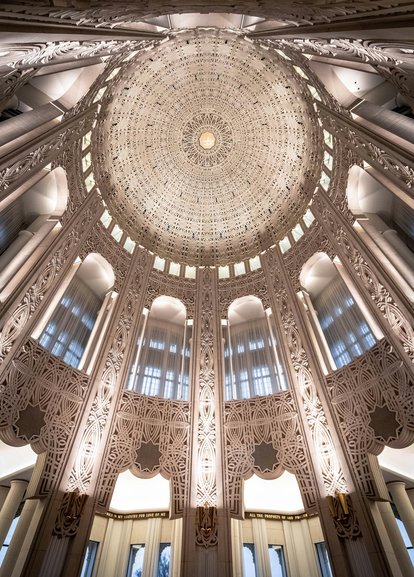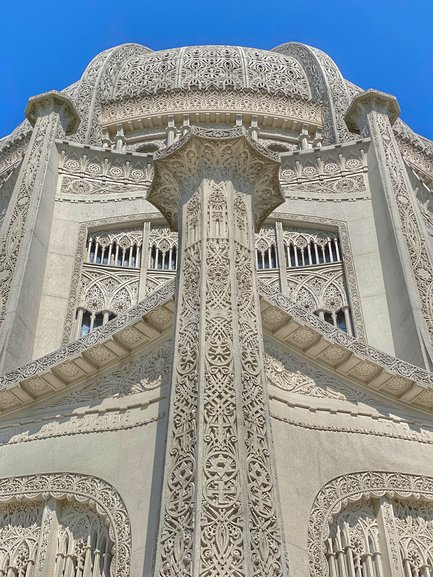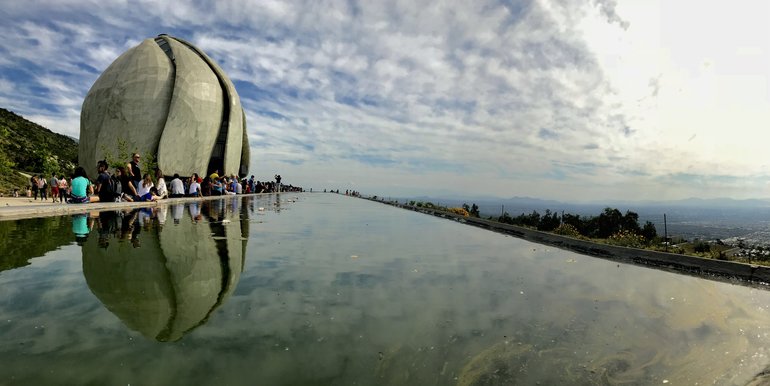Explore the Majestic Baháʼí House of Worship in Chicago, USA
Are you planning to visit Chicago?
Please do not miss the opportunity to see the Temple of All Religions.
The Temple of All Religions in Chicago, also known as the Baháʼí House of Worship, is a stunning architectural masterpiece that stands as a symbol of unity and tolerance for all faiths. This temple welcomes visitors of all backgrounds to come together in peace and harmony.
Wilmette's Bahá'í House of Worship is the oldest surviving among just seven worldwide.
Contents
What is the Bahá'í religion?
The Baháʼí Faith is a monotheistic religion founded by Baháʼu'lláh in the 19th century in Persia (modern-day Iran). Its core belief is the unity of all people and religions, emphasizing that humanity is one family and that the world's major religions come from the same divine source, progressively revealed by different prophets throughout history. Baháʼís believe in the oneness of God, the oneness of religion, and the oneness of humanity.
Key Teachings of the Baháʼí Faith:
Oneness of Humanity: Baháʼís believe that all humans are equal, regardless of race, nationality, or gender, and that the elimination of prejudice is essential for global peace.
Progressive Revelation: Baháʼís view religious truth as revealed progressively over time by messengers such as Abraham, Moses, Buddha, Jesus, Muhammad, and Baháʼu'lláh. Each of these figures brought a message suited for their time, contributing to humanity's spiritual and social evolution.
Unity of Religion: Baháʼís teach that all major world religions are valid, share common spiritual truths, and stem from the same divine source. The differences are seen as reflections of cultural contexts and the needs of the time.
World Peace and Justice: Central to Baháʼí teachings is the idea that peace is achievable through global cooperation, the establishment of universal laws, and the recognition of humanity's oneness. It emphasizes justice, equality of men and women, and the need for global governance to address challenges like poverty and conflict.
Education and Science: The Baháʼí Faith encourages education for all and believes that science and religion are in harmony. Both are seen as tools to understand truth and advance civilization.
Service to Humanity: Baháʼís are called to serve others and contribute to the betterment of the world through personal and collective efforts.
Baháʼí Practices:
Daily Prayer: Baháʼís are encouraged to pray and meditate on their spiritual duties and relationship with God.
Fasting: Baháʼís observe a fast each year from sunrise to sunset for 19 days before their New Year (Naw-Rúz) in March.
Community Life: There is no clergy in the Baháʼí faith. The Baháʼí community is governed by elected bodies such as the Local Spiritual Assembly and the Universal House of Justice.
Baháʼu'lláh's vision for humanity includes principles such as the elimination of extremes of wealth and poverty, the establishment of a world language, and the promotion of education and moral development for all people.
The Baháʼí Faith is present in nearly every country worldwide, with millions of followers working toward the ideals of unity, justice, and peace.
History
The [](https://www.bahai.us/bahai-temple-welcome/bahai-temple/) Bahá'í House of Worship is named "Bahá" which means "glory" or "splendor" in Arabic. Bahá represents the Baháʼí Faith's primary teachings and values, emphasizing divine glory, and provides a place where people from all backgrounds can come together to worship spiritual ideas that promote unity and peace.
In 1903, a small group of Baháʼís in Chicago discussed constructing a Baháʼí House of Worship. At the time, the world's first was built in Ashgabat, Russian Turkestan (now Turkmenistan). Corinne Knight True, a Baháʼí from Chicago, visited ʻAbdu'l-Bahá in 1907 and received his blessing for the project. Thornton Chase, another early Baháʼí, also requested guidance and in 1909, the first national Baháʼí council was elected.
ʻAbdu'l-Bahá, son of Baháʼu'lláh, the founder of the Baháʼí Faith, became the Faith's leader after his father's death. His name means "Servant of the Glory," reflecting his dedication to Baháʼu'lláh and the Baháʼí teachings. ʻAbdu'l-Bahá played a key role in spreading the Baháʼí Faith globally and interpreting his father's teachings. As an essential figure,
ʻAbdu'l-Bahá traveled widely, including Europe and North America, promoting unity, peace, and social justice. He was chosen as the authorized interpreter of Baháʼí teachings, making his explanations and publications essential for understanding the religion. He is highly respected for his wisdom, compassion, and contributions to advancing human rights and interfaith communication.
ʻAbdu'l-Bahá recommended building the temple near Lake Michigan and the group chose a site in Wilmette, Illinois. Corinne True became the project's treasurer and earned the title "Mother of the Temple" for her efforts. Funds were raised globally, and in 1912, ʻAbdu'l-Bahá laid the symbolic cornerstone.
Construction began in the 1920s using a design by architect Louis Bourgeois. By 1922, Foundation Hall was completed, but progress slowed due to financial problems and local opposition. In the 1930s, construction resumed, with the superstructure finished in 1931 and the exterior completed by 1943. Interior work continued, and plans for the temple gardens were approved in 1951. The temple became a significant landmark, even serving as a meeting place for the U.S. Navy during WWII.
Design
The Baháʼí Houses of Worship, also known as Mashriqu'l-Adhkár (Arabic for "Dawning-place of the mention of God"), embody the principles of unity, diversity, and harmony central to the Baháʼí Faith. Open to all, regardless of religion or background, these temples are places for prayer, meditation, and community gatherings. Their architecture is notable for its beauty and symbolism, reflecting spiritual concepts in physical form.
One of the most famous Baháʼí Houses of Worship is in Wilmette, Illinois, designed by French-Canadian architect Louis Bourgeois and completed in 1953. Its lace-like exterior features nine sides and nine entrances, symbolizing the world's major religions:
Christianity – Based on the life and teachings of Jesus Christ, it is the world's largest religion, with various denominations such as Catholicism, Protestantism, and Eastern Orthodoxy.
Islam – Founded on the teachings of the Prophet Muhammad, Muslims follow the Quran and the Five Pillars of Islam. The main branches are Sunni and Shia.
Hinduism – One of the oldest religions, primarily practiced in India, it encompasses a variety of beliefs, including the concepts of karma, dharma, and moksha.
Buddhism – Based on the teachings of Siddhartha Gautama (the Buddha), it focuses on achieving enlightenment through the Four Noble Truths and the Eightfold Path.
Sikhism – Founded by Guru Nanak in the 15th century in India, Sikhs believe in one God and follow the teachings of the ten Sikh Gurus, compiled in the Guru Granth Sahib.
Judaism – The monotheistic religion of the Jewish people, centered on the covenant between God and the Israelites, with teachings found in the Torah.
Baháʼí Faith – Founded by Baháʼu'lláh in the 19th century, it teaches the unity of all religions and humanity, emphasizing peace, equality, and justice.
Taoism – A Chinese philosophy and spiritual tradition founded by Laozi, it emphasizes living in harmony with the Tao (the Way), which is the underlying principle of the universe.
Shinto – The indigenous religion of Japan, it focuses on rituals and devotion to kami (spirits or deities), emphasizing the connection between nature and the divine.
These religions represent a wide range of beliefs and traditions, and the Baháʼí temple's nine-sided architecture honors their contributions to humanity.
Each column of the temple is crowned with a nine-pointed star, the symbol of the Baháʼí Faith.
Key Elements of Baháʼí Temple Design:
Baháʼí temples, known for their intricate design and deep symbolism, incorporate various symbols that reflect key spiritual concepts of the Baháʼí Faith. These symbols convey messages of unity, divinity, and interconnectedness, and are integrated into both the architecture and decoration of the temples.
Nine-Pointed Star
The most prominent symbol in Baháʼí architecture is the nine-pointed star. This star appears frequently throughout Baháʼí Houses of Worship, especially in the design of columns, windows, and external details.
Symbolism of Nine: The number nine is significant in the Baháʼí Faith, representing completeness and unity. Nine is the highest single-digit number, symbolizing the fulfillment of spiritual goals and the unity of all people and religions.
Unity of Religions: The nine points of the star represent the nine major world religions—Christianity, Islam, Hinduism, Buddhism, Sikhism, Judaism, Baháʼí Faith, Taoism, and Shinto—emphasizing the unity of all faiths in worshiping one God.
Nine doors
The nine-sided (nonagonal) structure of Baháʼí temples is central to their symbolic design. The circular layout creates a harmonious, inclusive space with no beginning or end, symbolizing eternity and the unity of all people.
Inclusiveness: The nine-sided design, with its corresponding nine doors, signifies that people from all faiths, cultures, and walks of life are welcomed into the Baháʼí House of Worship.
Completion and Perfection: The shape symbolizes completeness and spiritual wholeness, reflecting the Baháʼí principle of the unity of humanity and the oneness of God.
Greatest Name
Another key symbol in Baháʼí temples is the Greatest Name, a calligraphic symbol representing Baháʼu'lláh, the founder of the Baháʼí Faith. This symbol often appears in various artistic forms within the temple, including inscriptions, decorations, and wall art.
Meaning: The Greatest Name, often written as "Yá Baháʼu'l-Abhá" (meaning "O Glory of the Most Glorious"), represents the glory and majesty of God. It is a reminder of the divine presence and the spiritual foundation of the Baháʼí Faith.
Position: While the Greatest Name is sometimes inscribed inside Baháʼí temples, it is often placed in a central, sacred position, symbolizing the temple's focus on divine unity.
Central Dome
The dome is a key architectural and symbolic feature of Baháʼí Houses of Worship. The central dome, soaring above the structure, represents the oneness of God and the unity of all people under one divine creator.
Connection Between Heaven and Earth: The dome creates a symbolic link between heaven and earth, reflecting spiritual aspirations and the goal of bringing divine qualities into the material world.
Unity of Humanity: The dome also symbolizes the unity of all people under one God, reinforcing the Baháʼí teaching that all humans are equal and should come together in worship and service.
No pulpit or altar
No pulpit or altar reflecting equality before God and the absence of clergy in the Baháʼí Faith, these temples have no religious hierarchy, offering a space for communal and individual worship.
Gardens and Nature
Baháʼí temples are surrounded by beautifully landscaped gardens, which are seen as an extension of the temple's spiritual purpose. The gardens are not just decorative but carry deep symbolic meaning.
Harmony Between Humanity and Nature: The gardens symbolize the connection between humanity and the natural world, reflecting the Baháʼí teaching that nature and human life are deeply interconnected.
Spiritual Reflection: The carefully designed gardens are peaceful spaces that encourage reflection, meditation, and spiritual connection, mirroring the inner beauty of the temple.
Light
Natural light plays a significant symbolic role in Baháʼí temple design. The temples often use large windows, skylights, or intricate latticework to allow natural light to flood the interior.
Symbol of Divine Illumination: Light symbolizes the guidance and illumination provided by divine truth. It is a metaphor for spiritual enlightenment, with the temple acting as a beacon of spiritual knowledge and truth for humanity.
Transparency and Clarity: The use of natural light also represents transparency, clarity, and the purity of intention that the Baháʼí Faith encourages in worship and life.
Architectural Diversity
Baháʼí Houses of Worship reflect unity in diversity by incorporating local architectural traditions and materials, while maintaining the spiritual principles of the Faith.
Cultural Integration: Each temple reflects local culture in its design:
The Wilmette Temple blends Gothic, Romanesque, and Eastern influences.
The Lotus Temple in India takes the shape of a lotus, symbolizing purity.
The Santiago Temple in Chile uses translucent glass and marble, evoking a flower in bloom.
In Samoa, the Baháʼí temple has a circular design that represents community and togetherness, which are important elements in the local culture and Baháʼí belief.
In Germany, the Baháʼí temple integrates modern European style with traditional features, symbolizing Faith's desire for unity in a continually modernizing world.
The Sydney Baháʼí temple combines Australian and indigenous culture, creating a unique local expression of the worldwide Baháʼí message of unity and peace.
Local Materials: Temples often use regional materials to emphasize spiritual connection to the earth, such as white marble in India or Chilean marble in Santiago.
Nature and Harmony: Surrounding gardens highlight harmony between humanity and nature, like the reflective pools in Wilmette or the natural hillside setting of Santiago.
Verses and Sacred Texts
In many Baháʼí Houses of Worship, verses from Baháʼu'lláh's writings and other sacred texts are inscribed on the walls or placed in prominent areas of the temple. These texts are often presented in a simple, elegant manner to encourage reflection and meditation.
Spiritual Teachings: These inscriptions serve as reminders of the core teachings of the Baháʼí Faith, including the oneness of humanity, the unity of religion, and the importance of service to others.
Inclusion of Other Scriptures: In line with the Baháʼí belief in the unity of all religions, texts from other religious traditions may also be included, further symbolizing the openness and inclusivity of the Faith.
Other symbols in Baháʼí Temples
Baháʼí temples incorporate symbols from various religious traditions to reflect the unity of all faiths and humanity. Each symbol represents spiritual concepts shared by diverse cultures and beliefs.
Cross: A central symbol in Christianity, representing the sacrifice and teachings of Jesus Christ. Its presence in Baháʼí architecture reflects the unity of all messengers of God.
Star of David: Originating in Judaism, the six-pointed star signifies divine protection and the connection between God and humanity. In Baháʼí contexts, it reinforces the harmony between different faiths.
Swastika: An ancient symbol used in Hinduism, Buddhism, and Jainism, it represents well-being, prosperity, and good fortune. In Baháʼí temples, it symbolizes spiritual progress and the cyclical nature of existence. Later, the Nazis appropriated this symbol, distorting its meaning to represent hatred and tyranny, which contrasts sharply with its original spiritual value.
Nine-Pointed Star: A uniquely Baháʼí symbol, representing completeness and the unity of religions. The number nine is the highest single-digit number, symbolizing wholeness and inclusion of all spiritual paths.
Five-Pointed Star: The five-pointed star often represents the unity of humanity and the diversity of the world's religions. It serves as a reminder that all faiths lead to the same divine truth.
The Greatest Name: A calligraphic symbol representing Baháʼu'lláh, the founder of the Baháʼí Faith. It consists of the letters B and H in Arabic, symbolizing the glory of God and the centrality of Baháʼu'lláh's teachings.
Crescent Moon: Often associated with Islam, the crescent moon symbolizes the ongoing development of humanity and the growth of spirituality, signifying a new spiritual dawn.
Circle: A common motif in Baháʼí architecture, the circle represents eternity and the oneness of God. It symbolizes the wholeness of creation and the interconnectedness of all life.
Open Book: Sometimes depicted in Baháʼí imagery, the open book symbolizes the unfolding of spiritual knowledge and the importance of studying sacred texts.
Tree of Life: This symbol can represent spiritual growth, connection to the divine, and the flourishing of human potential within the Baháʼí teachings.
Butterfly: Symbolizing transformation and spiritual evolution, the butterfly is often associated with personal growth and the journey of the soul.
These symbols, drawn from multiple traditions, illustrate Baháʼí principles of spiritual unity and respect for all faiths, reinforcing the temple's message of inclusion and interconnectedness.
How many Baha'i temples are there?
There are currently 11 Baháʼí Houses of Worship worldwide, with each temple representing a distinct geographic region and serving as a spiritual focal point for Baháʼís and the surrounding community. Of these, 10 are continental temples, while 3 are national or local houses of worship.
Continental Baháʼí Temples:
Wilmette, USA (Dedicated in 1953): The first Baháʼí temple in the Western Hemisphere, with its intricate lace-like exterior symbolizing unity.
Kampala, Uganda (1961): The African temple, noted for its dome reflecting indigenous architectural elements.
Sydney, Australia (1961): Known for its simplicity, combining modernist and local styles.
Panama City, Panama (1972): With its towering dome, it emphasizes the harmony between humanity and nature.
Apia, Samoa (1984): Reflects Pacific island influences, and was the first temple built in Oceania.
New Delhi, India (1986): The famous Lotus Temple, known for its lotus-shaped design.
Frankfurt, Germany (1964): The European temple, minimalistic in design with a central dome.
Santiago, Chile (2016): A striking modern design with translucent panels, symbolizing light and spirituality.
Battambang, Cambodia (2017): The first local Baháʼí House of Worship, emphasizing simplicity and local design.
Mati, Papua New Guinea (2021): Recently dedicated to serving the local community.
Tanna, Vanuatu (2021): Designed to reflect local traditions and cultures.
Several more national and local temples are under construction or in planning stages, as the Baháʼí Faith continues to expand its emphasis on communal worship and service.
Visiting the Baháʼí House of Worship in Chicago
Baháʼí House of Worship
100 Linden Ave
Wilmette, IL 60091, USA
Dress Code for the Baháʼí House of Worship
While there is no formal dress code for visiting the Baháʼí House of Worship, visitors are encouraged to dress modestly and respectfully. Here are some general guidelines to consider:
Modest Attire:
It's advisable to wear clothing that covers shoulders and knees. This shows respect for the spiritual nature of the temple and its purpose as a place of worship.
Comfortable Footwear:
As visitors may walk around the gardens and explore the grounds, wearing comfortable shoes is recommended.
Avoiding Distracting Clothing:
Avoid clothing with offensive graphics or language, as well as overly casual attire like swimwear or pajamas.
Admission:
Admission to the Baháʼí House of Worship is FREE for all visitors. There are no entrance fees or tickets required.
Guided Tours: While the temple is open for self-guided exploration, guided tours may be available. Please check the official website or contact the temple for specific details about tour availability and schedules.
How to Get There:
The temple is located about 14 miles north of downtown Chicago.
By Car:
Take I-94 North (Edens Expressway) and exit at Dempster St. (Exit 37)
Head east on Dempster St. until you reach Linden Ave, then turn left to find the temple.
By Public Transit:
From downtown Chicago, you can take the Purple Line Express from Howard Station. Get off at the Wilmette Station.
From Wilmette Station, it's about a 20-minute walk (approximately 1 mile) to the temple. You can also take a local bus (such as the 213 or 423) for a shorter walk.
Parking:
There is a parking lot available at the temple for visitors.
The Baháʼí House of Worship in Wilmette, Illinois, stands as a beautiful testament to the principles of unity, diversity, and inclusivity at the heart of the Baháʼí Faith. Its stunning architecture, rich symbolism, and serene gardens offer visitors a unique space for reflection and spiritual growth. Whether you're interested in architecture, spirituality, or simply seeking a peaceful retreat, this temple is a must-see destination.
If you find yourself in Chicago, don't miss the opportunity to visit this remarkable landmark and experience the welcoming spirit of the Baháʼí community. It's not just a place of worship; it's a celebration of the interconnectedness of all humanity.
Enjoy your visit!
North America Religion Temples United States Architecture Chicago Illinois
Share this tip:
Written by Suitcase Travel blog
See also
Accommodations
Tours and activities
NYC Bridge and River Bicycle Tour
The Bridge and River tour is a scenic 3-hour bicycle tour will take you from the Upper West Side of New York City up and over the George Washington Bridge for a ride along the river on Route 9W. Get the full touring experience and leave New York City for a few hours. During the ride, we make stops at Grants Tomb Memorial on the Upper West Side.
Historical Charleston Walking Tour
Licensed Charleston Tour Guide, Mansions, Gardens , Rainbow Row, French Quarter, Churches, Historic Landmarks, Civil War History, Slave Trade History, Revolutionary War History...


